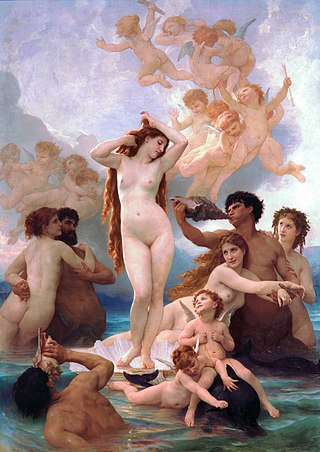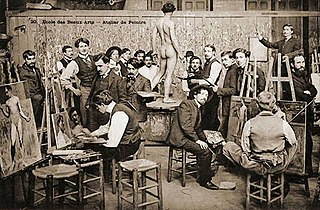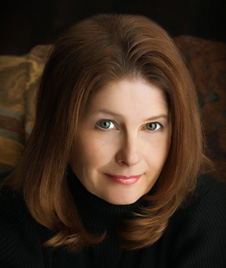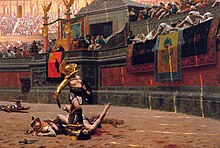
Academic art, or academicism or academism, is a style of painting and sculpture produced under the influence of European academies of art. Specifically, academic art is the art and artists influenced by the standards of the French Académie des Beaux-Arts, which was practiced under the movements of Neoclassicism and Romanticism, and the art that followed these two movements in the attempt to synthesize both of their styles, and which is best reflected by the paintings of William-Adolphe Bouguereau, Thomas Couture, and Hans Makart. In this context it is often called "academism," "academicism," "art pompier" (pejoratively), and "eclecticism," and sometimes linked with "historicism" and "syncretism." Academic art is closely related to Beaux-Arts architecture, which developed in the same place and holds to a similar classicizing ideal.

A figure study is a drawing or painting of the human body made in preparation for a more composed or finished work; or to learn drawing and painting techniques in general and the human figure in particular. By preference, figure studies are done from a live model, but may also include the use of other references and the imagination of the artist. The live model may be clothed, or nude, but is usually nude for student work in order to learn human anatomy, or by professionals who establish the underlying anatomy before adding clothing in the final work.

Robert Hale Ives Gammell was an American artist best known for his sequence of paintings based on Francis Thompson's poem "The Hound of Heaven". Gammell painted symbolic images that reflected his study of literature, mythology, psychology, and religion.
Burton Silverman is an American artist.

An atelier is the private workshop or studio of a professional artist in the fine or decorative arts or an architect, where a principal master and a number of assistants, students, and apprentices can work together producing fine art or visual art released under the master's name or supervision.

Robert Beverly Hale was an artist, curator of American paintings at the Metropolitan Museum of Art, and instructor of artistic anatomy at the Art Students League of New York and the Pennsylvania Academy of Fine Art. He was also the author of the well-known book Drawing Lessons from the Great Masters, as well as the translator of the classic anatomy text Artistic Anatomy by Dr. Paul Richer.

Jacob Collins is an American realist painter working in New York City. He is a leading figure of the contemporary classical art revival.

Realism in the arts is generally the attempt to represent subject matter truthfully, without artificiality and avoiding speculative and supernatural elements. The term is often used interchangeably with naturalism, although these terms are not synonymous. Naturalism, as an idea relating to visual representation in Western art, seeks to depict objects with the least possible amount of distortion and is tied to the development of linear perspective and illusionism in Renaissance Europe. Realism, while predicated upon naturalistic representation and a departure from the idealization of earlier academic art, often refers to a specific art historical movement that originated in France in the aftermath of the French Revolution of 1848. With artists like Gustave Courbet capitalizing on the mundane, ugly or sordid, realism was motivated by the renewed interest in the common man and the rise of leftist politics. The Realist painters rejected Romanticism, which had come to dominate French literature and art, with roots in the late 18th century.

Graydon Parrish is a realist painter living in Austin, Texas. He is both trained in and an exponent of the atelier method which emphasizes classical painting techniques.

The Boston School was a group of Boston-based painters active in the first three decades of the twentieth century. Often classified as American Impressionists, they had their own regional style, combining the painterliness of Impressionism with a more conservative approach to figure painting and a marked respect for the traditions of Western art history. Their preferred subject matter was genteel: portraits, picturesque landscapes, and young women posing in well-appointed interiors. Major influences included John Singer Sargent, Claude Monet, and Jan Vermeer. Key figures in the Boston School were Edmund C. Tarbell, Frank Weston Benson, and William McGregor Paxton, all of whom trained in Paris at the Académie Julian and later taught at the School of the Museum of Fine Arts. Their influence can still be seen in the work of some contemporary Boston-area artists.
The contemporary realism movement is a worldwide style of painting which came into existence c. 1960s and early 1970s. Featuring a straightforward approach to representation practiced by artists such as Philip Pearlstein, Alex Katz, Jack Beal and Neil Welliver. The movement refers to figurative art works created in a natural yet highly objective style. Today the term Contemporary Realism encompasses all post-1970 sculptors and painters whose discipline is representational art, where the object is to portray the "real" and not the "ideal".

Lyndall Bass is an American realist painter and teacher who primarily paints still lifes, flower paintings and symbolist figure paintings. She lives and works in Santa Fe, New Mexico. She is the designer of the current reverse of the Lincoln cent, which has been in use since 2010.
Peter Seitz Adams is an American artist. His body of work focuses on landscapes and seascapes created en plein air in oil or pastel as well as enigmatic figure and still-life paintings. He is noted for his colorful, high-key palette and broad brushwork. Adams has held numerous solo and group exhibitions in galleries and museums, including throughout California, the Western United States, and on the East Coast in Philadelphia, Vermont, and New York. Adams is the longest serving President of the California Art Club and has served on its board of directors in Pasadena, California from 1993 to 2018. He is also a writer on subjects relating to historic artists for the California Art Club Newsletter, as well as for a number of the organization's exhibition catalogs.
Aleksander Balos is a Romani-Polish-American artist and figurative painter, known for his classical photorealistic paintings depicting contemporary subject matter and narrative. He currently lives in the United States and is a naturalised American.
Patricia Watwood is an American figurative painter living in Brooklyn, NY.

Realism was an artistic movement that emerged in France in the 1840s, around the 1848 Revolution. Realists rejected Romanticism, which had dominated French literature and art since the early 19th century. Realism revolted against the exotic subject matter and the exaggerated emotionalism and drama of the Romantic movement. Instead, it sought to portray real and typical contemporary people and situations with truth and accuracy, and not avoiding unpleasant or sordid aspects of life. The movement aimed to focus on unidealized subjects and events that were previously rejected in art work. Realist works depicted people of all classes in situations that arise in ordinary life, and often reflected the changes brought by the Industrial and Commercial Revolutions. Realism was primarily concerned with how things appeared to the eye, rather than containing ideal representations of the world. The popularity of such "realistic" works grew with the introduction of photography—a new visual source that created a desire for people to produce representations which look objectively real.
Contemporary-Traditional Art refers to an art produced at the present period of time that reflects the current culture by utilizing classical techniques in drawing, painting, and sculpting. Practicing artists are mainly concerned with the preservation of time-honored skills in creating works of figurative and representational forms of fine art as a means to express human emotions and experiences. Subjects are based on the aesthetics of balancing external reality with the intuitive, internal conscience driven by emotion, philosophical thought, or the spirit. The term is used broadly to encompass all styles and practices of representational art, such as Classicism, Impressionism, Realism, and Plein Air painting. Technical skills are founded in the teachings of the Renaissance, Academic Art, and American Impressionism.
Harriet Shorr, was an American artist, writer, poet and professor. She was known for large-scale realistic still life paintings.

Richard Frederick Lack was an American artist, educator, and writer. He is known for his work in all major genres of traditional art. He founded Atelier Lack in 1969 to train students interested in learning the skills necessary to create fine representational art, and he initiated the use of the term “Classical Realism” as an artistic designation. He trained thirty-one artists who taught or opened ateliers.
Atelier Lack was a studio school of drawing and painting established in 1969 by Minnesota artist Richard F. Lack. It was incorporated as a non-profit corporation in 1971. Richard Lack had studied with Boston artist, R. H. Ives Gammell, in the 1950s. In 1967 Lack had written "On the Training of Painters," an examination of the training of painters throughout the history of Western art, and his judgment about the superiority of the atelier, or studio system. The first years of the school were helped by three grants from The Elizabeth T. Greenshields Memorial Foundation in Montreal, Canada, “to help initiate an atelier for the purpose of training young students in the traditional craft of painting...”













